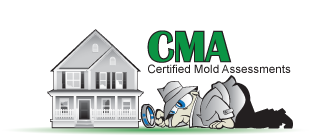The Why?
Water intrusion problems and other maintenance issues in any home can be better addressed when the owner is aware of the issue at hand. The adage “An ounce of prevention is worth a pound of cure” could not ring more true when it comes to homeownership and creating and maintaining good air quality.
Most of us in the modern world live in structures that have running water in pipes behind the walls and HVAC units with complex ductwork to cool and heat our air. There is always risk involved; there is no such thing as a perfect home, especially as our homes age. However, awareness of your home’s weak spots and addressing minor problems before they become big problems can avoid extreme issues down the line. In many cases, this may be the difference between a whole-house mold issue and a small water damage problem that you can remediate quickly, safely, and effectively (with the right team, of course!).

The Context of Our Inspection Tips
If you choose to move forward with yearly inspections, we recommend doing them at the same time every year on a day you can easily remember. This can be after the new year, around tax season, before your climate’s rainy season or even on a loved one’s birthday! For your first annual inspection, you may want a home or mold inspector’s guidance to learn the process. However, the tips we are sharing with you below are in the DIY spirit. After all, you live in the home and are the person who will gain the most benefit in learning as much as you can about preventative maintenance.
These recommendations also assume that you have already done extensive testing on your home to make sure you are living in a mold-free or ERMI-safe home. Ermi-level cleaning is essential for those living with CIRS or Lyme Disease. We recommend mold testing and water damage assessment when you move into a new home, whether it is a rental or a property that you own.
Preventative Maintenance, Mold Basics
On to the fun part, how can you keep your clean home safe? There are a few things you can do that can help your home stay clean and dry all year long!
- Consider humidity meters throughout your home. These measure the humidity in real-time. Over time, you will see what is typical for your home and climate. If a meter in a particular room of your home starts to spike higher regularly, you know there may be an issue in that area of your home.
- If you have CIRS, it is not a bad idea to ERMI your home yearly.
- Change your air filters monthly and always check with your HVAC company to ensure that your air filters will not restrict your system’s airflow.
- As mentioned in other articles, an air purifier such as the IQAir Multi-gas is an excellent investment that can keep mycotoxin and VOC levels low.
- Fog regularly (monthly or yearly).
- Use a HEPA vacuum and vacuum regularly. Keeping dust to a minimum will help to keep mold spores at bay.
- Use a dehumidifier.
- Ensure all wet areas are tiled, and the grout and caulk are correctly installed, following the manufacturer’s guidelines. Tiling behind vanities and toilets is a great idea.
- Consider your flooring before or when you move in. Carpets can harbor mycotoxins. Some flooring is higher in VOCs, and some options, such as engineered wood, can commonly trap moisture between the subfloor and the flooring. Tile and luxury vinyl plank flooring are good choices, appropriately installed, of course.
- Be mindful of the maintenance schedule of your HVAC, all appliances, water heater, roof, and siding as necessary.
- Keep plant growth away from home.
- Notice throughout the year if you have condensation on your windows – this can be a sign of a more significant issue.
- Verify that the discharge from gutters/downspouts flows away from the foundation.
Equipment to Have on Hand
- As mentioned above: Mini-humidity meters.
- Air filters: consult your HVAC contractor for the best filter for your system.
- A hand-held humidity meter such as this one.
- A triple-axis EMF reader to test for EMF’s if you are EMF-sensitive.
- ERMI kits.
Your Annual Inspection Checklist
Checking on the following systems in your home on a yearly basis will help you catch any problem early. Early discovery of potential water intrusion issues is critical in preventing mold issues.
- Entire ventilation system:
Things to look for: dust, dirt, mold growth on vents or in ductwork (where visible).
Maintenance to perform: yearly cleaning of the air handler. Clean out the condensate drain line.
- Attic and/or crawlspace:
Things to look for: staining to sheathing and framing members, water-damaged insulation in the attic, or damp soil in the crawl space.
- Windows
Things to look for: cracking around frame/sill. Staining on the sill. Gaps in the seal around the window. Delamination of the window framing.
Maintenance to perform: hire window contractor to evaluate caulking and weather stripping seals
- Grading
Things to look for: sloping towards the home, saturated soil, pooling water.
Maintenance to perform: make sure drainage systems (if necessary) are free of debris.
- Gutters
Things to look for: clogged gutters, downspouts should be directed away from the foundation.
Maintenance to perform: monthly check to make sure gutters are not clogged and downspouts are intact.
- Water heater
Things to look for: assess the pan beneath the unit to see if there is any rust or standing water in the pan.
Maintenance to perform: drain and flush to prevent deposit build-up.
- Roof
Things to look for: loose, missing or mishapen shingles or tiles, leaks and water discoloration on the ceiling or in attic.
Maintenance to perform: inspect attic after heavy storms. For serious concerns, contact a licensed roofing contractor.
- Underneath sinks
Things to look for: staining to the base cabinet, leaks in drain and supply lines.
Maintenance to perform: routine cleaning of drain lines (stiff snake brush and non-toxic cleaning products).
This may seem like a lot of work at first, but with practice, looking for these issues will become second nature and part of your normal maintenance routine. Most importantly, knowing your house’s strengths and weaknesses will ease your anxiety and allow you to enjoy the place you chose to call home for years to come.
For more tips, or if you are interested in learning how to prevent future mold issues or address current ones, please follow us on Instagram and Facebook. .
Book your inspection today! We look forward to continuing the conversation.
